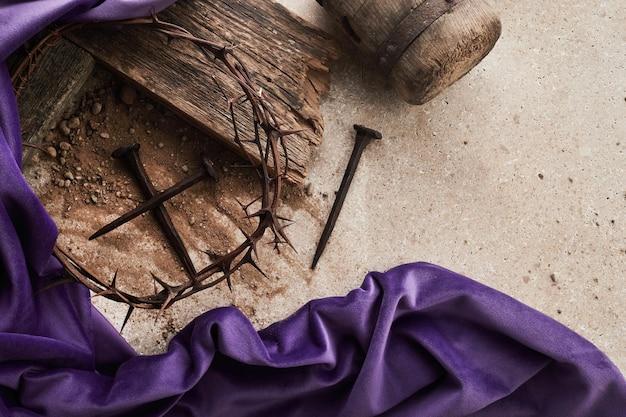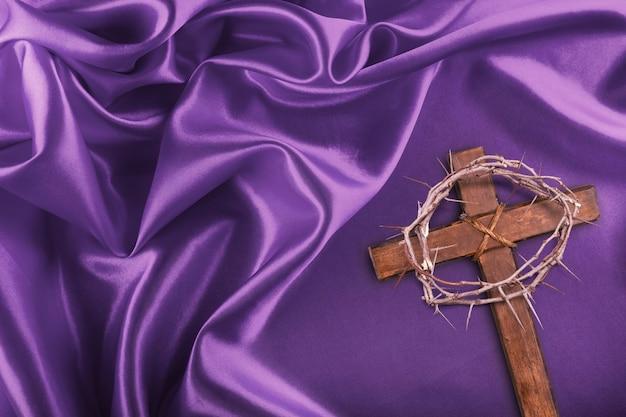Have you ever wondered about the significance of the purple robe often depicted on the cross? In this blog post, we will dive deep into the history, symbolism, and religious meanings associated with this mysterious hue. From its association with Lent and Easter to its portrayal in biblical texts, we will explore the various interpretations and explore answers to questions like why Jesus was adorned with a purple robe during his crucifixion.
Throughout history, the color purple has held diverse connotations, ranging from royalty and power to penance and sorrow. It is a hue that has captivated artists, theologians, and the faithful alike. Join us as we unravel the symbolic threads that connect the purple robe on the cross to the life, death, and resurrection of Jesus Christ. So, let’s delve into the depths of this enigmatic color and discover how it intertwines with the rich tapestry of religious symbolism.
Stay tuned to unveil the deeper meanings behind the purple robe on the cross and explore the fascinating narratives surrounding its usage throughout religious history.

What Does the Purple Robe on the Cross Mean
Have you ever wondered about the significance of the purple robe on the cross? It’s not just a random detail – it holds a deeper meaning that adds to the story of Jesus’ crucifixion. So, let’s unravel the mystery behind the purple robe and its significance in this captivating subsection!
The Symbolism of the Color Purple
Purple has long been associated with royalty, wealth, and power. In ancient times, purple dye was expensive to produce, making it a color reserved for the elite. So, when Jesus was draped in a purple robe before his crucifixion, it signified a mockery of his claim to kingship.
Mocking Jesus’ Kingship
The soldiers who crucified Jesus were well aware that he had been referred to as the “King of the Jews.” In their mocking, they sought to belittle him and his authority. By adorning him with a purple robe, they sarcastically pretended to honor his claim to kingship while simultaneously ridiculing him.
Adding Insult to Injury
Not only did the soldiers mock Jesus with the purple robe, but they also placed a crown of thorns on his head. This cruel act aimed to intensify the humiliation he endured. While the crown of thorns represented his suffering, the purple robe symbolized the mockery directed at his divine authority.
Reflecting Jesus’ True Kingship
Ironically, the soldiers unknowingly portrayed Jesus’ true kingship through their mockery. As the King of Kings, Jesus conquered sin and death through his sacrificial death on the cross. Despite their intentions, the soldiers unwittingly emphasized Jesus’ true divine authority and power.
A Reminder of Jesus’ Selflessness
The purple robe serves as a reminder of Jesus’ selflessness and humility. Despite being the King of Kings, he willingly endured humiliation and suffering for the sake of humanity. The purple robe on the cross symbolizes his sacrifice and unwavering love for mankind.
A Call to Embrace Humility
As followers of Christ, the purple robe on the cross calls us to embrace humility in our own lives. It reminds us that true greatness lies in selflessness and service to others. Just as Jesus embraced his mock kingship, we are called to be humble and compassionate towards those around us.
The purple robe on the cross is not merely a colorful detail in the crucifixion story – it holds deep symbolism and significance. It represents the soldiers’ mockery of Jesus’ claim to kingship while inadvertently affirming his true divine authority. It serves as a powerful reminder of Jesus’ humility and selflessness, calling us to embrace these virtues as well. So, let us reflect on the purple robe and its meaning whenever we contemplate the crucifixion of Jesus Christ.

FAQ: What Does the Purple Robe on the Cross Mean
Is “The Color Purple” a True Story
No, “The Color Purple” is a work of fiction written by Alice Walker and published in 1982. While it explores various themes and issues, including spirituality, it is not based on a true story.
What Does Purple Mean at Easter
Purple is the liturgical color associated with the season of Lent and Easter in many Christian traditions. It represents penance, preparation, and sacrifice, reflecting the introspective and solemn nature of this holy period.
What Does God Symbolize in the Color Purple
In “The Color Purple,” God symbolizes hope, redemption, and spiritual guidance. The characters’ relationship with God is portrayed as a source of strength and resilience in the face of adversity.
What Does “Amen” Mean at the End of a Prayer
“Amen” is a word of Hebrew origin that means “so be it” or “truly.” It is commonly used at the end of prayers to express agreement, affirmation, and a sense of finality.
What Are the Themes in “The Color Purple”
Some of the central themes in “The Color Purple” include the power of female relationships, the effects of oppression and abuse, the pursuit of self-discovery and empowerment, and the importance of spirituality and faith.
What Color Is Jesus’s Clothes
The Bible does not specifically mention the color of Jesus’s clothes. Different artistic representations have depicted him wearing various colors, but the focus of his teachings and actions goes beyond external appearances.
Why Is Purple Used on Ash Wednesday
Purple is used on Ash Wednesday, which marks the beginning of Lent, as a symbol of repentance, humility, and mourning. It reminds Christians of their mortality and the need for spiritual renewal.
What Does the Purple Cloth on the Cross Mean
The purple cloth on the cross often symbolizes royalty and majesty. In the context of Jesus’s crucifixion, the purple cloth may represent the mocking of his claim to be the King of the Jews.
What Color Was Mary Magdalene
There is no definitive historical or biblical account of Mary Magdalene’s exact skin color. She is widely believed to have been a Jewish woman from ancient Palestine.
What Is the Most Evil Color
Colors themselves do not possess inherent evil. However, throughout history, certain colors have been associated with negative connotations in different cultures and contexts. It’s important to note that interpretations of color symbolism can vary widely.
Why Are Purple Vestments Used during Lent
Purple vestments are used during Lent as a visual reminder of the season’s significance. The color symbolizes penance, humility, and the anticipation of Jesus’s resurrection on Easter Sunday.
Who Wears Purple in the Catholic Church
In the Catholic Church, bishops and archbishops typically wear purple robes, known as cassocks or choir robes, during liturgical ceremonies. The color signifies their rank within the hierarchy.
What Religion Is “The Color Purple” in
“The Color Purple” is not a religious text; it is a novel that explores various themes, including spirituality. It portrays the experiences and perspectives of African American women in the early 20th century.
Is Purple the Color of Death
Purple is not universally regarded as the color of death. In some cultures, black is associated with death and mourning, while others associate white or other colors with the end of life.
Crucifixion of Jesus – The Last Moments Before His Death: Why a Purple Robe
According to the Gospel accounts, Roman soldiers dressed Jesus in a purple robe before his crucifixion as a cruel gesture. It was intended to mock his claim to be a king, adding insult to the physical and emotional torment he endured.
What Color Was Jesus’s Robe When He Died
The Bible does not provide specific details about the color of Jesus’s robe at the moment of his death. Historical records and artistic interpretations have varied, but the focus remains on the significance of his sacrifice, not the color of his clothing.
Why Is the Purple Sash on the Cross at Easter
The purple sash on the cross during Easter serves as a visual representation of Christ’s suffering and ultimate triumph over sin and death. It signifies the sacrifice and redemption celebrated during this time of the Christian calendar.
Why Did Jesus Have a Purple Robe
Jesus was given a purple robe before his crucifixion as a mocking gesture by Roman soldiers. It was meant to ridicule his claim to be the King of the Jews and to further degrade him before his crucifixion.
Why Is Purple Evil
Purple, as a color, is not inherently evil. It is often associated with luxury, royalty, and spirituality. Negative connotations may arise from historical or cultural contexts, but it is important to differentiate between symbolic associations and intrinsic qualities of colors.
What Does the Purple Robe Mean in the Bible
The purple robe in the Bible, specifically in the context of Jesus’s crucifixion, symbolizes the humiliation and mockery he endured before his death. It represents the rejection of his claim to kingship by his captors.
What Does the Color Purple Mean Negative
Colors can have different meanings in various contexts. While purple is often associated with mysticism, royalty, and spiritual depth, negative interpretations may arise based on cultural beliefs, personal associations, or specific circumstances. It is essential to consider the broader context when interpreting color symbolism.
What Does a Robe Symbolize in the Bible
In the Bible, a robe often symbolizes authority, dignity, and honor. It can represent distinctive roles, such as those of priests or kings, and may signify favor, righteousness, or consecration.
What Does Purple Symbolize in Lent
Purple symbolizes penance, preparation, and reflection during Lent. It serves as a visual reminder of the need for self-examination, repentance, and spiritual renewal leading up to Easter.
Why Does “The Color Purple” Start with “Dear God”
The opening line, “Dear God,” in “The Color Purple” emphasizes the protagonist’s reliance on faith and her desire for communication with a higher power. It sets the tone for the spiritual journey and themes explored throughout the novel.
Why Is the Color Purple Associated with Jesus
Purple is sometimes associated with Jesus due to its historical significance as a color associated with royalty. It represents his divine identity as the Son of God and the King of Kings, particularly in Christian art and symbolism.
Now that you have a comprehensive understanding of the purple robe’s significance, its role during Christ’s crucifixion, and its symbolism in literature and religious practices, you can delve deeper into the profound meanings and interpretations surrounding this captivating color.